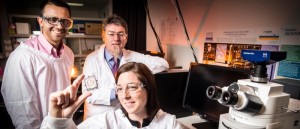3D Printing of Brain-like Tissues to Improve Drug Tests

Scientists from the ARC Centre of Excellence for Electromaterials Science (ACES) have developed a multi-layered structure of primary neural cells that imitates the brain structure. The finding, published in the journal Biomaterials, will improve the brain drug screening process by providing a better material to work in vitro than the ones currently used.
The brain is a very complex organ where cells are organized in several layers in various regions. Drug screenings for brain illnesses are carried out in animals, which is expensive for pharmaceutical companies and not very effective. Many drugs have different effectiveness in human and animal brains. Other companies perform in vitro tests in 2D cultures of brain cells, but this is not ideal since the brain has a specially convoluted structure. Dr. Wallace and coworkers decided to use the power of a fashionable technique: bioprinting. They obtained 3D brain-like structures made of six discrete layers of primary neural cells encapsulated in hydrogels. The team developed a special bio-ink with natural carbohydrates that allow cell dispersion throughout the structure and provide protection to the cells. The cells were accurately positioned and remained in their designated place, thus achieving the finest imitation of neural tissue so far. The hydrogel also ensured neural cell viability.
The 3D bio-printed neural tissue will be very useful to study cell behavior, brain injuries and neurodegenerative diseases. Future improvement of 3D printing technology coupled with use of biomaterials will result in the development of biostructures with finer resolution.
Source: ARC Centre of Excellence for Electromaterials Science

